Dongdong Zou
Hardware-Efficient and Reliable Coherent DSCM Systems Enabled by Single-Pilot-Tone-Based Polarization Demultiplexing
Jul 14, 2024Abstract:Recently, coherent digital subcarrier multiplexing (DSCM) technology has become an attractive solution for next-generation ultra-high-speed datacenter interconnects (DCIs). To meet the requirements of low-cost and low-power consumption in DCI applications, a comprehensive simplification of the coherent DSCM system has been investigated. The pilot-tone-based polarization demultiplexing (PT-PDM) technique, known for its low-power consumption and ultra-fast polarization tracking capabilities, has emerged as a compelling alternative to the power-hungry N-tap adaptive multi-input multiple-output (MIMO) equalizer. However, the effectiveness of this PT-PDM technique is extremely vulnerable to the receiver-side XY-skew (Rx-XY-skew), which is revealed in this paper for the first time. Then, a pilot-tone-enabled modified Godard phase detector (PT-MGPD) scheme is proposed to realize Rx-XY-skew estimation, serving as the prerequisite for the successful implementation of the PT-PDM and simplification of the adaptive equalizer. Both the simulation and experiment are conducted to evaluate the accuracy of the proposed PT-MGPD scheme. The results prove it can achieve accurate estimation with an error of less than 0.3ps. Besides, a low-complexity, high-spectral-efficiency, and ultra-fast polarization demultiplexing method based on a single pilot tone (SPT) is proposed for the DSCM system in this work. Based on the proposed PT-MGPD and SPT schemes, the conventional N-tap MIMO equalizer served for each subcarrier can be successfully pruned into two polarization-independent single-input single-output equalizers, and there is no performance penalty even if the polarization rotation speed reaches 10Mrad/s. According to the results, the proposed schemes provide a hardware-efficient and reliable coherent DSCM solution for next-generation ultra-high-speed DCIs.
Simplified Self-homodyne Coherent System Based on Alamouti Coding and Digital Subcarrier Multiplexing
Mar 18, 2024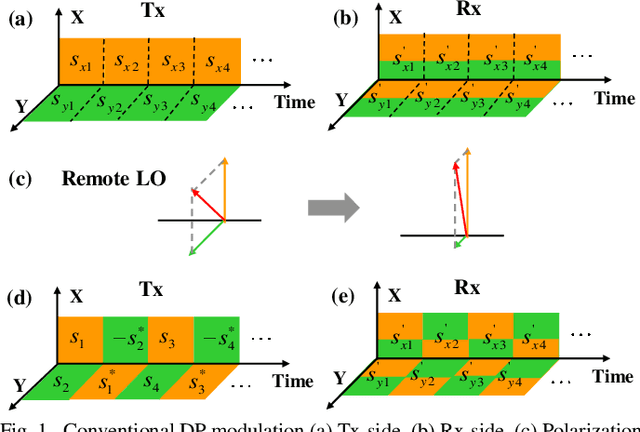
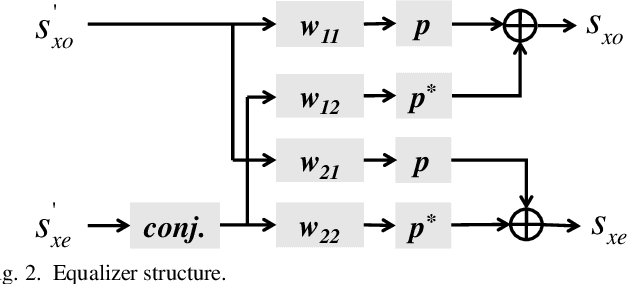
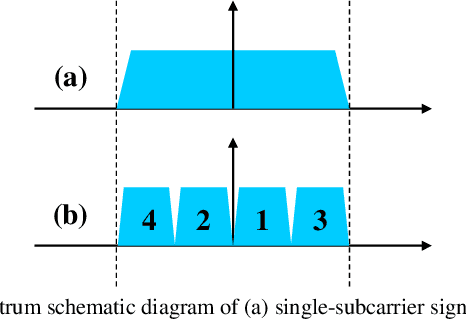
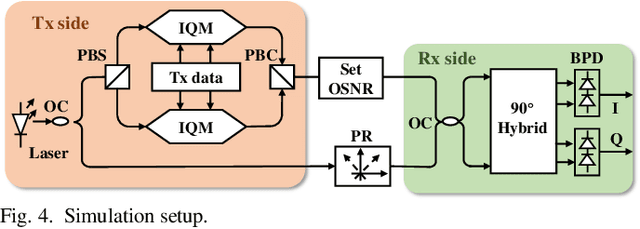
Abstract:Coherent technology inherent with more availabledegrees of freedom is deemed a competitive solution for nextgeneration ultra-high-speed short-reach optical interconnects.However, the fatal barriers to implementing the conventiona.coherent system in short-reach optical interconnect are the costfootprint, and power consumption. Self-homodyne coherentsystem exhibits its potential to reduce the power consumption ofthe receiver-side digital signal processing (Rx-DSP) by deliveringthe local oscillator (LO) from the transmitter. However, anautomatic polarization controller (APC) is inevitable in the remoteLO link to avoid polarization fading, resulting in additional costsTo address the polarization fading issue, a simplified self.homodyne coherent system is proposed enabled by Alamouticoding in this paper. Benefiting from the Alamouti coding betweentwo polarizations, a polarization-insensitive receiver onlyincluding a 3dB coupler, a 90o Hybrid, and two balancedphotodiodes (BPDs)is sufficient for reception. Meanwhile, theAPC in the LO link is needless, simplifying the receiver structuresignificantly. Besides, the digital subcarrier multiplexing (DSCM)technique is also adopted to relax the computational complexity ofthe chromatic dispersion compensation (CDC), which is one of thedominant power consumption modules in Rx-DSP. Thetransmission performance of 50Gbaud 4-subcarrier 16/32OAM(4SC-16/320AM) DSCM signal based on the proposed simplifiedself-homodyne coherent system is investigated experimentallyThe results show that the bit-error-ratio(BER) performancedegradation caused by CD can be solved by increasing 4 taps inthe equalizer for 80km single mode fiber(SMF)transmissionwithout individual CDC, which operates in a low-complexitymanner.
Theoretical Evaluation of the Capacity-Achieving Distribution for IM-DD Fiber-Optic Channels
Feb 23, 2023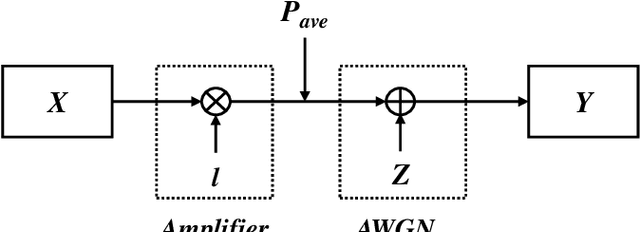

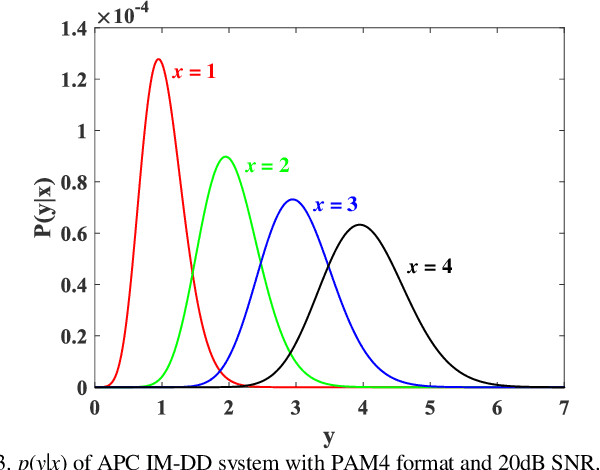
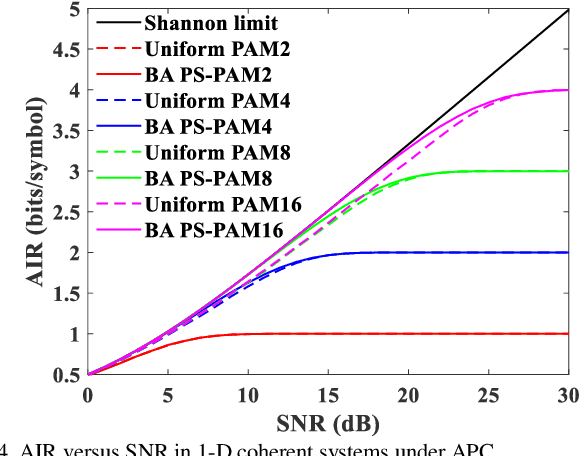
Abstract:The capacity and capacity-achieving distribution for intensity-modulation and direct-detection (IM-DD) fiber-optic channels is theoretically investigated. Different from coherent fiber-optic channels, we indicate that the capacity-achieving distribution of IM-DD systems should be discussed separately in two cases: 1) IM-DD systems without optical amplifier, which are constrained in peak power; 2) IM-DD systems with optical amplifier, which are the average power constraint (APC) system. For the two models, the maximum mutual information achieving distribution, instead of the maximum input entropy achieving distribution, is numerically computed by the iterative Blahut-Arimoto (BA) algorithm. For the IM-DD system under peak power constraint (PPC), a dynamic-assignment BA algorithm is applied to find the capacity-achieving distribution with minimum cardinality. It is observed that the maximum difference between the minimum input cardinality and capacity is around 0.8 bits. For a fixed support input cardinality, although the observed shaping gain is small and only appears in low peak-signal-to-noise ratio (PSNR) regions in the PPC IM-DD system, the probabilistic shaping technique can also be used to introduce rate adaptation to the system by adjusting the shaping and FEC overheads since the capacity-achieving distribution is symmetric. In the IM-DD system under APC, a modified BA algorithm is investigated to solve for the capacity and capacity-achieving distribution, and a significant shaping gain is observed. For PAM8 and PAM16 modulation formats, 0.294 bits/symbol and 0.531 bits/symbol shaping gain can be obtained at the SNR of 20dB. Furthermore, since the capacity-achieving distribution is asymmetric in this case, a practical discussion of the PS technique is also presented.
 Add to Chrome
Add to Chrome Add to Firefox
Add to Firefox Add to Edge
Add to Edge